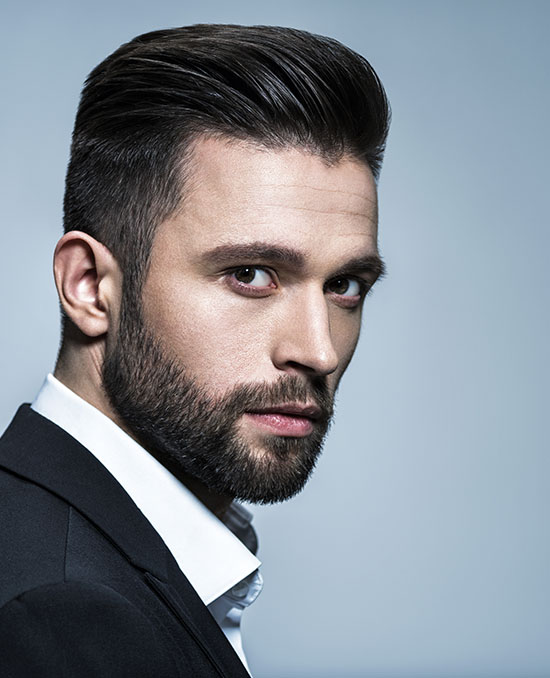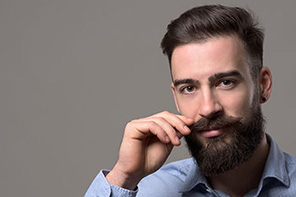
Cirugía De Trasplante De Barba
El trasplante de barba se realiza mediante injertos de folículo piloso de la parte del donante, que se realiza mediante un proceso indoloro con anestesia local, las personas pueden obtener una barba natural y estética. La Operación de Transplante de Barba da resultados satisfactorios. La operación es realizada por un médico y un equipo de expertos en un entorno saludable del quirófano. Turquía es el país más privilegiado del mundo con técnicas avanzadas y modernas.

Las Causas De Las Perdidas De Barba
La pérdida de la barba, crea incomodidad en términos de apariencia estética, conduce a problemas sociales y psicológicos. Existen diferentes causas que afectan la calidad de la barba y causan la caída del cabello:
- Deficiencia de hormona Di Hydro Testosterone (DHI),
- Trastornos hormonales,
- Cicatrices y quemaduras,
- Diversas enfermedades de la piel
- Los códigos genéticos.
Un médico especialista debe ser admitido para investigar la causa debajo del derrame. Especialmente los trastornos hormonales y las enfermedades metabólicas deben estar cuidadosamente estudiadas. Si el pico o la dilatación son persistentes, la operación de trasplante de barba es la solución más efectiva para afeitar la barba y dar una apariencia saludable y natural.

- Personas que han perdido una parte de su barba debido a cicatrices o quemaduras,
- Personas que nunca han tenido barba debido a la predisposición genética
- Personas con barba asimétrica,
- Personas que quieran cambiar o corregir la forma de barba,
- Las personas que tienen una pérdida de barba y tienen un área de donantes adecuada,
- El trasplante de barba se puede aplicar después de la pubertad.
La operación de trasplante de barba se aplica no solo en personas que no tienen barba, sino también en personas con una barba débil o escasa y una estructura de bigote. El trasplante de barba también se puede realizar en los casos en que los folículos pilosos son insuficientes o no hay barba. En algunos trastornos, como enfermedades cardíacas, presión arterial, diabetes, hepatitis B y otros, se puede realizar un trasplante de barba después de la verificación y aprobación del médico.

When Hair Is Not Growing In The Face Area: You can spot the lack of hair growth in the face, in one part or in the whole face. Male testosterone hormone, also known as DHY, is a factor that determines the growth of beards. These hormones which begin with puberty and grow until 20-21, help the hair grow and increase its density. Therefore, in case of lacking of these hormones, the beard may not grow.
Trichorrhexis: Not only the beard, but also all the hair in the body can fall off by a skin disease. Tricorrhexis, which may cause voids in different areas of the beard in the size of the coin or in the entire beard. Stress, boredom, fear, anxiety, sadness and psychological problems lead to hair loss. When the doctor’s recommended drugs did not treat these problems, the most effective way is Beard Transplant.
Scars Of Wounds And Burns: After several accidents, scars and burns may occur on the face and hair follicles may die in these areas and prevent the growth of the beard. You can get rid of these scars and get your beard again by doing Beard Transplant.
Intensity Or Reshape The Beard: Some beards may be light or shapeless. In such cases, a Beard Transplant can be performed without losing the natural appearance in order to increase the density of the beard or change its shape.

The beard is examined by your doctor before the operation to determine if you are suitable for Beard Transplant. It is recommended not to shave before the examination so that your doctor can see the normal growth of your beard. In addition, blood tests are performed to verify your health condition before the operation. There are some important things to consider before you do the operation:
Aspirin, vitamins and blood transfusions should be avoided a week before the procedure. Alcohol and cigarettes should be avoided too a week before the operation. It is preferable to wear a wide shirt, which is easy to take off at the operation day. You should inform your doctor about all the medications you use before the procedure. Beard Transplant is a very sensitive procedure, because it is done in the face area. Therefore, following your doctor’s tips will pass the process easily.
- People who have lost a large part of their beard due to scars or burns.
- People who have no facial hair due to hereditary reason.
- People with inconsistent beard.
- People who want to change or modify the shape of their beard.
- People who suffer from beard loss.
- People who passed puberty can do Beard Transplant.
Also people whom their beard structure is weak can have Beard Transplant, not only those who do not have beard because of a hereditary disease. In addition, Beard Transplant can be performed when the hair follicles are insufficient.
In some diseases such as heart disease, blood pressure, diabetes and hepatitis, Beard Transplant can only be done after the examination and approval of the doctor.
When Hair Is Not Growing In The Face Area: You can spot the lack of hair growth in the face, in one part or in the whole face. Male testosterone hormone, also known as DHY, is a factor that determines the growth of beards. These hormones which begin with puberty and grow until 20-21, help the hair grow and increase its density. Therefore, in case of lacking of these hormones, the beard may not grow.
Trichorrhexis: Not only the beard, but also all the hair in the body can fall off by a skin disease. Tricorrhexis, which may cause voids in different areas of the beard in the size of the coin or in the entire beard. Stress, boredom, fear, anxiety, sadness and psychological problems lead to hair loss. When the doctor’s recommended drugs did not treat these problems, the most effective way is Beard Transplant.
Scars Of Wounds And Burns: After several accidents, scars and burns may occur on the face and hair follicles may die in these areas and prevent the growth of the beard. You can get rid of these scars and get your beard again by doing Beard Transplant.
Intensity Or Reshape The Beard: Some beards may be light or shapeless. In such cases, a Beard Transplant can be performed without losing the natural appearance in order to increase the density of the beard or change its shape.
The beard is examined by your doctor before the operation to determine if you are suitable for Beard Transplant. It is recommended not to shave before the examination so that your doctor can see the normal growth of your beard. In addition, blood tests are performed to verify your health condition before the operation. There are some important things to consider before you do the operation:
Aspirin, vitamins and blood transfusions should be avoided a week before the procedure. Alcohol and cigarettes should be avoided too a week before the operation. It is preferable to wear a wide shirt, which is easy to take off at the operation day. You should inform your doctor about all the medications you use before the procedure. Beard Transplant is a very sensitive procedure, because it is done in the face area. Therefore, following your doctor’s tips will pass the process easily.
Aseguramos la satisfacción de los pacientes en
todo tipo de tratamientos que realizamos.

Garret D'silva,

Kundan Mishra,

Helen Garcia,
During Beard Transplant Operation
In Beard Transplant procedure, the necessary tests are performed and the donor area is determined. Which is usually the back side of the head or any other hairy area in the body. After collecting the follicle, there is no trace left in the body, but the intensity of the hair is reduced as much as it was taken from the hair. For the beard area, in cases where the beard did not grow for any reason, usually the number of grafts will be between 1000 and 3000 grafts to obtain healthy results.
This procedure is made by FUE technique, which is also used in Hair Transplant. FUE, an abbreviation for Follicular Unit Extraction, is the removal of hair follicles from the donor area one by one using a special technological tool and implanted in the beard area. This device has special round pins with diameter 0.7 and 0.8 mm. In the FUE technique, without any incision in the donor area, the follicles taken one by one are transferred to the beard area during the same day, taking into consideration the growth trend. The follicles that have been removed lose their function in the absence of oxygen, and when waiting for a long time cause they are considered alive. Therefore, the follicles should be implanted in the beard as soon as they are picked up.
Once a sufficient number of follicles have been collected, channels in the skin are opened from 0.6mm to 0.8 mm. Since there is no cut in the skin, there are no scars or wounds after the operation. Beard’s hair will grow unilaterally as it is implanted. Because the roots are mono-root, that’s why the picked follicles from the donor area must be separated during the operation.
After Beard Transplant Operation
Thanks to modern technology used in Beard Transplant, quick and effective results are obtained. As with Hair Transplant, the patient does not need to stay in hospital after the operation. Patients will have red spots in the ducts due to blood clotting, but this is normal. In the first ten days, the ducts are closed, the follicles adjust, the roots are peeled and the hair falls when the face is washed. After the operation, the cultivated area is washed by the doctor and his crew. The cultivated beard becomes visible after red spots disappear with washing. As in Hair Transplant, after the second week, strong falls occur in the beard. This is a completely natural process, and after a short period of hair loss, the beard is renewed and lasts for a long time. With proper care, it takes about 6-9 months for the beard to take its final shape. There are some things to consider after the operation:
- Rest at home for 3 days after the operation.
- Regular use of medicines and care products provided by the doctor after the operation.
- Do not apply and kind of pressure on the cultivated area.
- Do not use the shaving machine without the doctor’s permission.
- Do not use any chemical product on the cultivated area.
- Use scissors the shorten the beard instead of shaving machine during the first month.
- Avoid exposure to direct sunlight , as much as possible, which can damage the skin and beard for the first 15 days after the operation.
- Be aware when sleeping to not place the cultivated area on the pillow for at least two nights after the operation.
- Avoid heavy sports, excitements and stress during the first week.
- The cultivated area must remain clean and healthy.








